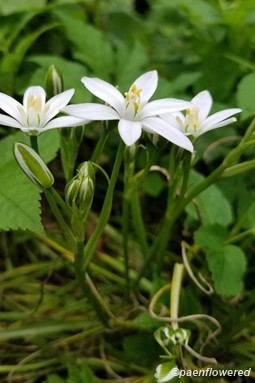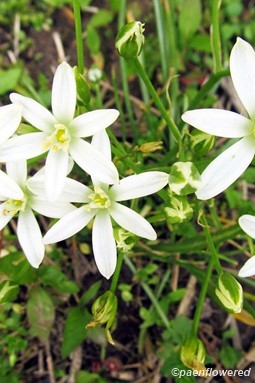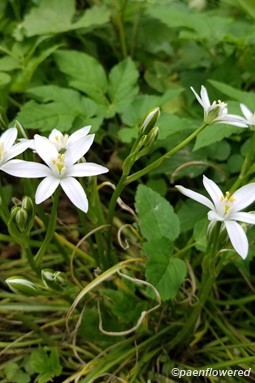Ornithogalum umbellatum
A naturalized white spring flower
Ornithogalum umbellatum garden star-of-Bethlehem
This perennial flower is not a native plant, but was imported from southern Europe, Southwest Asia and Northwest Africa as a garden plant. It has escaped cultivation and is now widely naturalized in much of the United States except in the dry and desert regions of the West. It is most common in the Northeast, where it is locally abundant. It had been classified as a member of the lily family, but has recently been reassigned to the family Asparagaceae.
This species has flowers with three petals and three sepals that are identical and thus the flower appears to have six petals. These are waxy and white in color. On the underside of each is a green stripe. The flowers are fragrant and attractive and about 1 ¼-inches in diameter. These flowers occur in clusters of 3-10 and these clusters tend to be flat-topped. The flowers usually open in the morning but often close by midday and then open again in the evening and close at night. The fruit is a 3-part capsule containing several black seeds. The blooming period lasts about two weeks from April to June.
The grass-like basal leaves are about ¼ inch wide and usually have a whitish midrib. The plants grow 4-12 inches high and the leaves can spread up to one foot wide. The plant can be found in semi-shaded fields, roadsides, near houses, and in open woodland environments. It requires considerable moisture during the winter and spring but can survive summer drought. After blooming the plant goes into dormancy. In some places it can spread aggressively and be abundant enough to be considered a weed, crowding out native species. It may also become a troublesome plant in lawns and on golf courses, as it is resistant to many non-specific herbicides.
The Star-of-Bethlehem plant grows from an underground bulb. Small bulb offsets are its major means of reproduction and these can be spread by water and grow in new locations. All parts of the plant, but especially the bulbs, are toxic as they contain cardiac glycosides. Livestock may be killed if they eat this plant but human poisonings are very rare.
Habitat & Range
Frequent in lawns and moist disturbed ground.
Mostly prevalent in the south of the state, but present all over.
| EMP: | FACU |
|---|---|
| NCNE: | FACU |
Phenology
Flowers April to June.
Plant Codes
S-rank: No Rank
G-rank: G4 (Apparently Secure)







Comments
Have you spotted this plant in your area? We'd love to hear about your experience! Share your comments or questions about the plant below. Comments are moderated before posting.